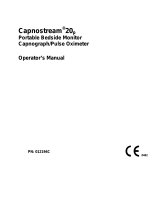
Support 1.800.635.5267 13 PM100N Home Use Guide
•The monitoring system’s screen contains toxic
chemicals. These chemicals do not touch the patient
or caregiver unless the screen is broken. Do not
touch a broken screen as this will result in contact
with toxic chemicals.
•The monitoring system should be placed beside the
patient on a sturdy surface. The device should be
securely held during transport and securely placed
during use. Injury to the patient or caregiver or
damage to the device may occur if the device falls.
•The monitoring system has been tested to
meet a variety of environments. In extreme
conditions, the device may not work properly. Such
conditions include, but are not limited to: Extreme
temperatures, excessive heat build-up, and certain
bright surrounding light conditions. Additionally,
the device’s display may be dicult to read in bright
light conditions.
•The monitoring system should be used with a
compatible, prescribed sensor. In some cases,
the sensor may not work properly if the sensor is
damaged, if the sensor connection fails, if the sensor
falls o the patient, or if the patient moves too
much. Some patients may experience skin irritation
at the sensor attachment site if the sensor is not
moved regularly.
•The monitoring system can be used on battery
power. An alarm will sound if the battery reaches a
low level. The monitoring system will turn o if the
battery power is completely lost.
Note: The low battery alarm duration may become
shorter over the lifetime of the battery.

























